
|

|
SPEX
Year: 1987
Type: Coupe
Class: mid-size Muscle Car
Host: GT4 & GT5
Country of Origin: USA
Price: 31,080 (GT4)
26,657
(GT5) GT5 Mileage as Tested: 17,824.8
Length: 200.6" // Width: 71.6" // Height: 54.6"
Wheelbase:
108.1"
Overhang: @ 7 feet 8 inches
Track: 59.4" [F] 59.3" [R]
Ground Clearance: 6.3"
Skidpad: 0.80g
Steering:
power-assist recirculating ball
Turns-Lock to Lock: 2.80
Construction: steel body on steel frame
Weight: 3,526
pounds
Layout: Front Engine / Rear Drive
Tires: P245/50VR-16 [F] P255/50VR-16 [R]
F. Suspension: wishbones / coils / anti-roll
bar
R. Suspension: live axle / coils / panhard torque arms
Brakes: vented discs [F] drums [R] GT5
car was given oil change and maintenance for all specs & testing below, so power could be matched nearest to the car in
GT4.
Engine: 3.8 liter OHV V6
Construction: cast iron block & heads
Aspiration: intercooled turbo (air to air)
GT4
GT5
Horsepower: 290 @ 4,400 rpm 288 @ 4,500
Torque:
378 @3,000 rpm 376 @ 3,000
Fuel System: sequential multi-point fuel injection
Valves / Cyl: 2
Bore x Stroke: 3.80 x 3.40"
Compression:
8.0:1
GT4 Redline: 5,600 // RPM Limit: 6,000
Idle Speed: 750-1,000 rpm GT5 Redline: 5,500
// RPM Limit: 6,000 Idle Speed: 750
Credits per HP: 107.17 97.29
Pounds per HP: 12.16 12.87
Hp per Liter: 76.5
Transmission:
4-speed automatic Differential: Limited-slip GT5 car was on Comfort Soft tires for
the speed from idle tests, but Medium Sports for the 4,000 rpm test.
``````````from idle ````````from 4,000 rpms
GT4 0-60 mph: 6.916
6.700 seconds
GT4 0-100mph: 15.235
15.093 seconds
GT5 0-60 mph: 6.260 5.895 seconds
GT5 0-100 mph: 15.223 14.763
seconds
GT4 400 M: 15.262 @ 98 14.316
@ 100 mph
GT4 1 KM: 26.985 @ 125 26.092
@ 123 mph
Test Track: 2:35.532
1:03.447 (Daytona)
Top Gear RPM @ 60 mph: 1,750
Brakes 100-0 mph: 4.67 seconds
Top Speed at Redline
1st: 43 mph
2nd: 79 mph
3rd: 126 mph
4th: 151.2 mph @ 4,600 rpm (GT4)
149.9 mph @ 4,600 rpm (GT5)
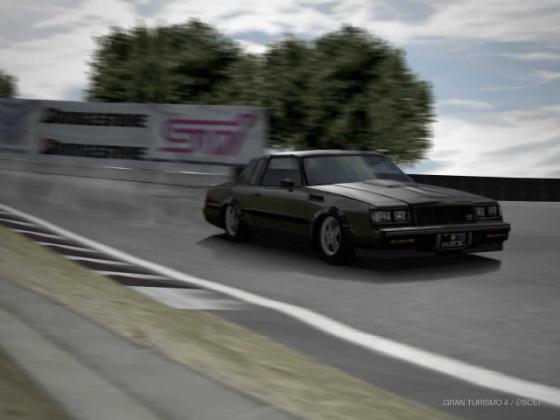
|
| bite the corkscrew! |
--------------EXTERIOR / HISTORY-----------
The Buick Regal GNX. There's an expression I'd love to start this essay with that
totally describes this ugly beauty as we first roll it out of the dealership and onto some Gran Turismo tarmac: All bark....little
bite!
Yes it has a deep, menacing growl...a brooding look, and can only be bought in black. But run it against
a slew of nimbler cars (real sports cars) and the GNX betrays itself quickly; for it is like that proverbial mean dog
running towards you from the scrapyard. YANK!! it reaches the end of its leash. The GNX/dog trips over its own feet
and (just for a moment) succumbs to its own clumsiness with a yelp.
This is how this car often begins its racing career.
Up against its own kind (other clumsy muscle cars), the GNX would feel more comfortable. In some ways it stands a better chance
than that crowd; but the reality is that Gran Turismo provides several hundred others that can easily kick this American's
ass straight up while still stock.
... why bother then? If the GNX barely wants to cooperate, if it has all the grace
of Rosanne on a skateboard, why would anyone ever want to buy or race one?
...because there's something brutish, something
masculine about the GNX. Something dominant. And sometimes... I just wanna take those AI bastards and give them
a slice of Grade-A Prime American Beef. Yuah, that's right. Take that, yall. Gimmee a hot dog
and make it snappy!! Take oNE FOR THA TEAM Go PATRIOTIC!!1
.
.
.
.
.
.
.
Uh sorry. Went on
a bit of a tangent there. Feel free to smack me next time that happens.
Anyways, suffice it to say this car kinda
sucks at first, but will it ultimately defeat? Will it ultimately devour? That's up to your persistance my friend. Read on.
...Some
say the Buick Grand National and GNX were the only true muscle cars from the era of Reagan, which is odd since neither has
a V8, and they lack natural old-fashioned carbureted power usually associated with American muscle. Those of you who
have never heard of this car probably have never heard of it for two reasons.
Number one, it's a Buick! Who ever
thought Buick made anything other than quiet, easygoing pillow-mobiles for grandpa? Buick's production of muscle cars in the
'60s and '70s pretty much ended with the gas crunch of 1974 and that was almost that.
Almost. And #2, the Regal series in the mid-80's was
rather staid...the Grand National and faster GNX models were made in limited numbers. Just 587 examples of the GNX were released
in this car's only year of existence. Buick was basically celebrating the Regal's last year as a rear-drive. Starting in 1988,
the Regal like so many others became a weaker, front-drive model...most of its prowess lost forever. Some also say GM execs
were worried Buick was about to out-trump Chevrolet's Corvette if they continued to produce cars like the Grand National and
GNX. I personally think Chevy had little to worry about. Few of us nowadays will ever have the chance to see a regular base-model
80's-era Regal, let alone the souped versions, thanks to these draconian decisions.
So the GNX is basically a car that
(like many others in our game) was built to appeal on an emotional level, during a time which very few manufacturers were
willing to risk a totally emotional approach. The 80's were largely a practical decade so far as car-making goes. Everyone
was trying to do things better. To improve. After the wanton 70's with its gas crunches and inefficient dinosaurs, one of
the last things we as Americans thought we should have was a bunch of gas-guzzing, inefficient vehicles. Even the Mustang
and Camaro from this era were a bit power-stricken and subdued. Japan was kicking our ass with efficient, practical (sometimes
sportier) cars while Europe was known for its high standards of luxury and quality. .....So we wind up with a machine like the GNX, and the largest car-maker in the world wisely saying "let's build
it, but oh...it would never sell in great numbers. It's not practical!'
Yet there is some practicality to the
big, black GNX (well, at least a bit of trunk space) but mostly...it is a car a bit out of step with its era. It wasn't a
luxury car. It wasn't a gas-sipper. It wasn't yet another car trying to appeal to the ever-growing lineage of Baby Boomers
who were looking for something to haul their kids to school and then commute safely to work. No, the GNX was a skeletal
frame sewn by mighty muscle--an attempted throwback to an earlier, simpler time; to be bought by a few who perhaps
psychologically were ready to return to this time while the masses cruised in their Citations and K-cars. This one has appeared in GT4 and GT5. In the earlier game, it's a zero-mileage
car which can be bought from Buick's Classic Car lot. We can get it used in GT5, and it's also slightly cheaper in this game
than it was in the previous.
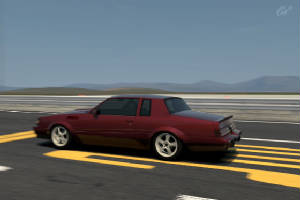
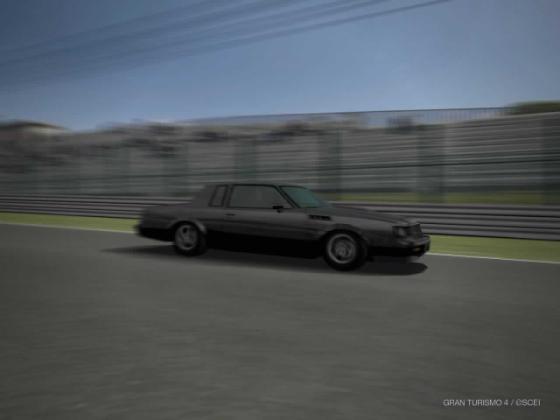
-------------ENGINE / DRIVETRAIN----------------
Anyways, like I said in the text above. It's unusual for an
American car to have a turbo, even nowadays. Not just a turbo, but an intercooled turbo, as if Buick really was commited
to making something happen at one point.
The GNX uses GM's famous 3.8 liter V6; an overhead-valve engine which
first saw light in the early 1960s, and was still in use in some models until the 2000s. In most of its other applications,
the 3.8 was not so mean as in the GNX. With this engine, engineers managed to acheive V8-like torque with a V8's power
curve as well, despite the fact that at 3.8 liters, the engine is rather small comparatively to many other "monsters". Again,
it's that "emotional" thing I was talking of. Sure, they could have configured for higher revs--but that would destroy the
feeling Buick knew their customers would crave. Another speculation is perhaps the redline is so low in an effort to keep
customers from blowing up their motor with excessive revving? Could be both.
But Buick using turbos didn't
start with the GNX in 1987. Starting in 1978, Buick boosted some of their engines with a turbo, an attempt perhaps
to get around government restrictions by keeping an engine smaller, but not giving up hope in the power department. The Regal's
two previous V8s (350 and 455 cubic-inch blocks) were weak despite their size, and didn't last thru the '70s as fuel-economy
measures killed sales, so the smaller V6 made sense in a way.
It's an odd fact when you think of it. At the time, hardly
anybody was producing turbos in mass-produced cars. Only Saab and Porsche were importing turbocharged vehicles into the States
in 1978, and there were no domestics with this configuration. The fact that Buick chose to spool some of their engines shows
a bit of courage and innovation on their part. Too bad they don't seem to have that sort of go-ahead lately, huh?
Anyhow...not much changed so far as power is concerned....turbo or no turbo.
...Till the '80s. But still, the top-line Grand National, which was inspired by Buick's NASCAR racing
program, posessed just 180 horsepower! Earlier examples were even weaker. The GNX in our game is also a bit tepid:
290 hp at just 4,400 rpm after maintenance is done to the stock motor! in GT4, and in GT5 I've seen used
cars rate as low as 261 before oil change and engine rebuilds. With both of these done, we've now got just below GT4's zero-mileage
car: 288 horses @ 4,500 rpm. This may seem a bit low in the grand scheme
of things, however the car also stomps out of those corners with 377 foot-pounds at a young
3,000 rpms, and this fat torque is by far the GNX's best asset while it's still unmodified.
And modifications can be
had! All 4 turbo stages in the fourth game as a matter of fact, which boost power past 600 hp....and that's
about all you'll ever need in this car, since it handles like a sack of cement at times. The GT5 car can accept this game's
mandated three NA kits, gets the three mandated turbos, but cannot accept a supercharger kit. Top power in this game remains
true to GT5, as we can see 494 horses @ 5,400 with 533 ft-lbs. at 3,900 with a Stage 3 NA
kit, or 624 horses @ 5,400 with 616 at 4,900 with the top turbo system.
Real-life Regals of all kinds (even the GNX) were equipped with automatic transmissions--either
a 3 or a 4-speed, so in my track testing I followed suit and roared off the quarter-mile, 1000 meter, and Top Speed tests
with an automatic of my own. Despite the fact that we've only got four gears, they are configured rather tall, so although
it may seem like we've got a sixties-era gearbox which will slow us down, we won't be seeing any sort of limit as we're
racing towards the stratosphere in this one, not until we've started heavily tuning, anyways. Acceleration.
Just how fast can this belated bull dog race across that scrapyard, anyways? The GNX
is supposed to be able to make 60 mph in just 4.7 seconds and the quarter in 13.2 @ 104 mph.
In my tests, I got nowhere near these real-life figures. It was only when equipped with S3 sport tires in GT4 that
the GNX started to approach these lower times, but I still couldn't match them. Something is wrong somewhere. PD is likely
at fault, since in real-life, the GNX's accelerating prowess has been well-documented from various car-magazines. Yes, the
margin of error for testing was greater back in '87 than it is now, since this was the era before computers did everything.
But we can assume zero to sixty in 4.7 seconds was certainly close enough to reality.
This is important. The reason
I'm making so much fuss about this topic is this: in 1987, the GNX was actually among the fastest accelerating cars of
its era. Only Porsches could come close to a GNX zero to 60 run. Corvettes from these days couldn't sink lower than 6.0
seconds, and that's with a manual tranny.
Anyways. Guess you know how the rest of this review is going to shape out.
American muscle. Lots of power....
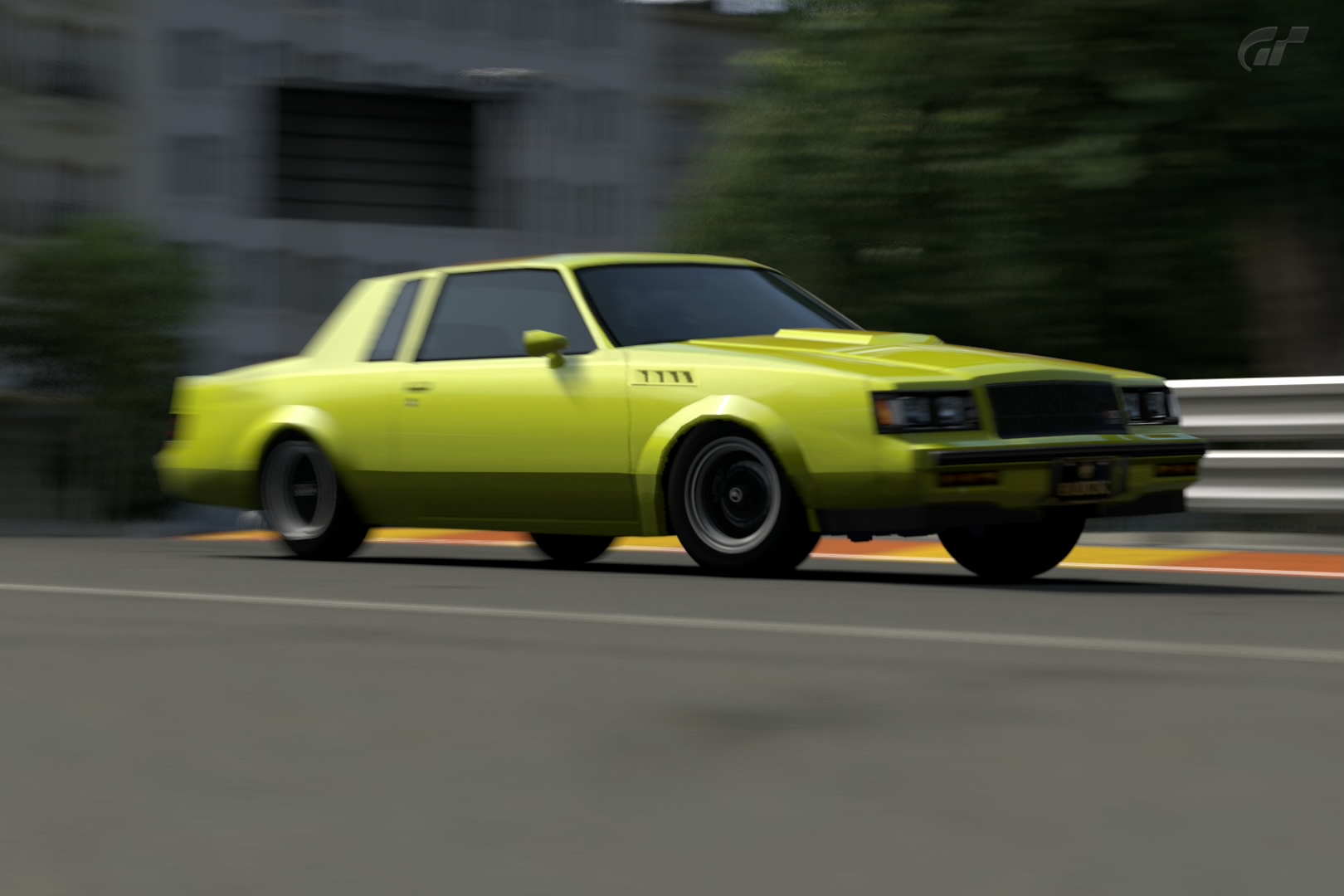
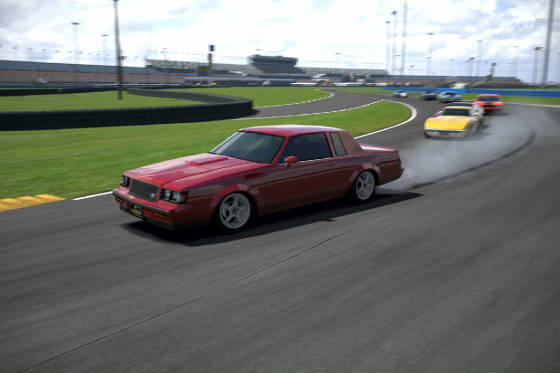
--------------CHASSIS / HANDLING------------------
....And scrumptiously poor handling!
And you'd be right, yet
by the time the Regal GNX was on the streets, many car-makers had learned some valuable lessons, so that the GNX is at least
equipped with tires more suited to the car's weight and stature. They even attempted a rather sportscar-like move, using
fatter tires on the rear than in the front. This helps deliver the fuel, helps get some of the engine's message sent.
But
still, the GNX suffers from these typicals in either GT4 or 5: weak springs, vague steering that grips too much at times yet
understeers at others, and a snappy booty (lots of trunk space = lots of rear overhang) that makes this car difficult to launch
when trying to navigate out of those corners; which sucks because "out of corners" is where it should be putting
down all that torque!
Of course, as we upgrade to better suspension, brakes, and tires, the GNX does start become more
and more manageable in the right hands. The above problems start to minimize except for the understeer in GT4, and excessive
oversteer in 5. Yes, the GNX is plagued by these faults, no matter how much money we dump into it. Understeer in GT4 and oversteer
in the latter game is something which can be reduced with some smart settings, but never truely goes away. Braking
in GT5 deserves a moment of mention. I've noticed in GT5 that this one (of course) brakes horribly, since it hasn't got ABS.
Braking in a straight line is rather safe, but there's always lots of twitching and snapping once we're needing to brake and
turn at the same time. Even when the braking is done, it can be difficult making those crucial moment from brakes to turn-in
to accelerating. Muscle cars from these days were never famous for their ability to transition inertia while turning, so none
of this comes as a surprise, so this text is merely being posted as a warning. Still, there are times when the GNX does manage a bit of grace
while cornering, but behind the scenes, there's always a driver who's working hard to keep it all under control. Scrapyard
dogs always need a good master, after all. Summary
Want to be the bad boy on your block, wearing all black, collecting pink slips all around, and
doing so with style? This could be your car. But in any other situation, the '87 Buick Regal GNX must be approached with
delicate care, for it is anything but delicate, and not very caring, either.
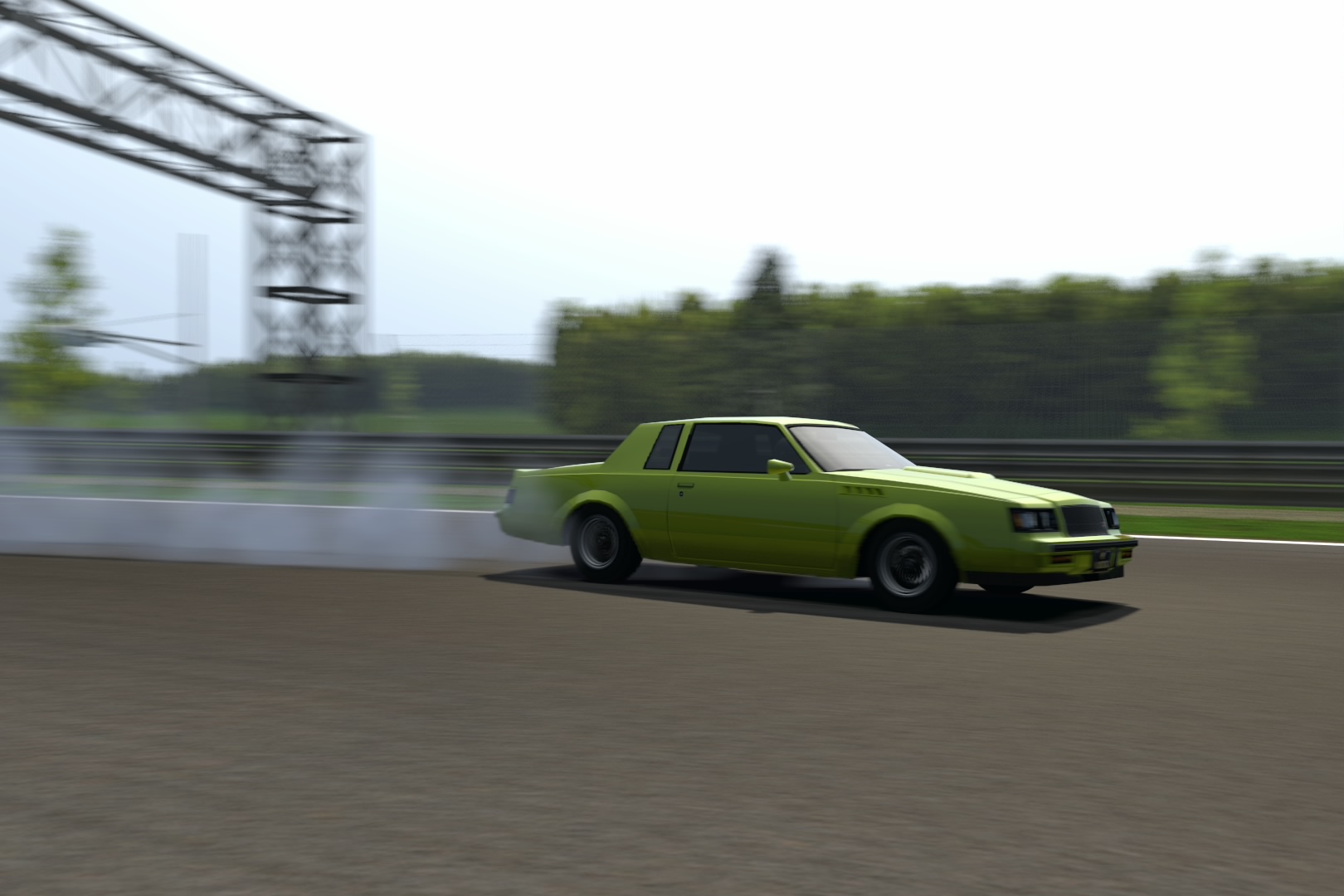
PROS------------------------------------------
1). Torque. Lots and lots of torque. Enough twist-force from the engine to pull a motorboat. Or
slay some AI as you leave those slow-fast corners! Once you figure how to get this car lined up, you'll be relying
on the engine's torque more often than you should.
2). All 4 turbo upgrades and intercooled, as well
in GT4 (GT5 only gives us 3). The cheaper stage 1 and 2 kits start us early with
some decent power.
3). Just love the manliness of this King! I only wish the GNX never made appearances as an AI car
so I'd have the only example in my game!
4). And a bassy engine-drone to compliment the menacing silhouette. The sports,
semi-racing, and racing exhaust never ruin the growls.
5). A fair price.
6). A burnout, donut, and drifting King. 7). The fact that the GNX is not too
powerful means it can do some earlier racing in GT5 than some other muscle cars. 8). GT5: A deep French horn-styled horn. Honk! CONS---------------------------------------------
1).
Muscle-car handling. Not as bad as a 60's or 70's machine, which isn't saying much. Understeers a lot early on, but oversteer
and snappyness also become a problem as we get more power. In GT5, sometimes oversteer can be a problem even before power
is highly boosted.
2). Long brake distances. Brake controller & sport package needed as soon as you can afford
them, if you're wanting to do any racing beyond the Beginner's League (GT4 only).
3). Just over 7 feet of overhang,
none of it aerodynamic. This is a car that needs constant thought given to weight transferance. What will happen as I
approach this corner? On some level the GNX always has me guessing, and not always in a good way.
4). Ugly?
Some would say so.
5). Just one color to buy, thanks to GM (not PD).
6). With a 5,500 rpm redline and peak power
at 4,400 or 4,500, this one is short on revs. Furlongs of torque, yet a tad low on horsepower for a turbocharged small-block
V6.
7). Weight.
8). Tall gearing, just 4 speeds. Good thing the mountain of torque does well getting the GNX/hulk
rolling, though.
9). A bit of turbo lag blooms into lots of spooling-action, which makes launching this car difficult.
Even with the best sports tires, I couldn't get near the real-life 0-60 time of 4.7 seconds.
10). That does it!
I need my Dokken shirt and I'm growing mullet!
Published: April 12,
2007 GT5 Info: November 27, 2013
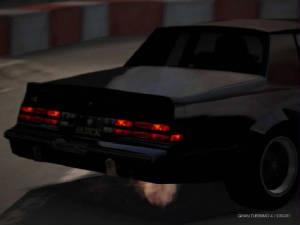
|

|

|

